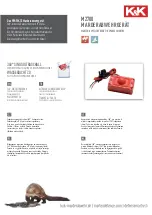
Detailed description
2.3 Continuous -path mode
Basic logic functions: Continuouspath Mode, Exact Stop, LookAhead (B1)
28
Function Manual, 11/2006, 6FC5397-0BP10-2BA0
Configuration
The rounding is configured with
G644
using the following machine data:
MD20480 $MC_SMOOTHING_MODE (comparison of the rounding with G64x)
The following options are available (the values should be entered in the thousand's place of
the machine data):
Thousand's place:
0xxx:
When rounding with
G644
, the maximum deviations of each axis specified with
the following machine data are used:
MD33100 $MA_COMPRESS_POS_TOL (maximum tolerance with compression)
1xxx:
Input the maximum rounding path by programming
ADIS=
... or
ADISPOS=
...(as
for
G641
)
2xxx:
Input the maximum possible frequencies of each axis in the rounding area using
the machine data:
MD32440 $MA_LOOKAH_FREQUENCY (smoothing frequency for LookAhead)
The rounding area is defined so that no frequencies in excess of the specified
maximum can occur while the rounding motion is in progress.
3xxx:
Any axis that has a velocity jump at a corner traverses around the corner with the
maximum possible dynamic response (maximum acceleration and maximum
jerk).
SOFT
: The jerk is limited.
BRISK
: When
BRISK
is active, only the acceleration is limited to its maximum
value.
With this setting, neither the maximum deviations nor the rounding distance are
checked.
The resulting deviations or rounding distances are determined exclusively by the
dynamic limits of the respective axis and the current path velocity.
While, with 3xxx, the rounding distance results exclusively from the dynamic response data
of the respective axis, in the other cases the distance to the corner at which the rounding
motion begins is checked. In the first two cases, the possible rounding distance is limited to a
maximum value, which results either from the defined maximum deviation or a direct
programming command.
In contrast, in the case of 2xxx, the rounding distance is limited to a minimum value, which
results from the maximum permissible excitation frequency and the current path velocity.
Additional limitation
Any further limitations are also effective in addition to this rounding distance limitation. The
rounding distance cannot exceed half the length of the original participating blocks.
The smoothing of the velocity jump on each axis and thus the shape of the rounding path
depends on whether an interpolation is performed with or without jerk limitation.
Consequently, a different velocity characteristic is produced for each axis, depending on
whether
BRISK
or
SOFT
is active.
BRISK
With
BRISK
, no jerk limitation is active; the acceleration of each axis reaches its maximum
value in the entire rounding area.
Summary of Contents for SINUMERIK 840D sl
Page 282: ...Index Basic logic functions Acceleration B2 64 Function Manual 11 2006 6FC5397 0BP10 2BA0 ...
Page 388: ...Basic logic functions Travel to fixed stop F1 Function Manual 11 2006 6FC5397 0BP10 2BA0 52 ...
Page 962: ...Index Basic logic functions Emergency Stop N2 20 Function Manual 11 2006 6FC5397 0BP10 2BA0 ...
Page 1704: ...Constraints Basic logic functions Spindles S1 94 Function Manual 11 2006 6FC5397 0BP10 2BA0 ...
Page 1716: ...Index Basic logic functions Spindles S1 106 Function Manual 11 2006 6FC5397 0BP10 2BA0 ...
Page 1996: ...Index Basic logic functions Tool Offset W1 208 Function Manual 11 2006 6FC5397 0BP10 2BA0 ...
Page 2150: ...Table of contents Basic logic functions Appendix 4 Function Manual 11 2006 6FC5397 0BP10 2BA0 ...
Page 2184: ...Glossary Basic logic functions Appendix 38 Function Manual 11 2006 6FC5397 0BP10 2BA0 ...
















































